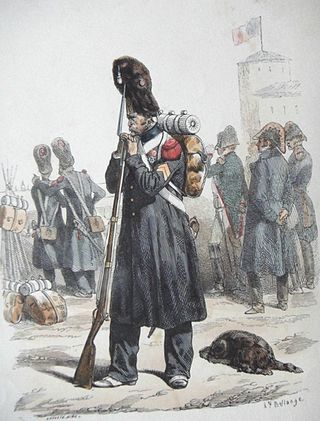
The Imperial Guard was originally a group of elite soldiers of the French Army under the direct command of Napoleon I, but grew considerably over time. It acted as his bodyguard and tactical reserve, and he was careful of its use in battle. The Guard was divided into the staff, infantry, cavalry, and artillery regiments, as well as battalions of sappers and marines. The guard itself as a whole distinguished between the experienced veterans and less experienced members by being separated into three sections: the Old Guard, Middle Guard and Young Guard. The Young Guard was virtually annihilated in the Battle of Krasnoi during the French invasion of Russia.

The King's German Legion was a British Army unit of mostly expatriated German personnel during the period 1803–16. The legion achieved the distinction of being the only German force to fight without interruption against the French during the Napoleonic Wars.
This article presents a timeline of events in the history of the United Kingdom from 1800 AD until 1899 AD. For a narrative explaining the overall developments, see the related History of the British Isles.
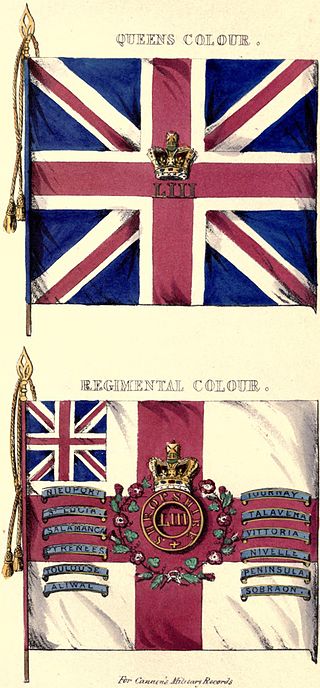
The 53rd (Shropshire) Regiment of Foot was a British Army regiment, raised in 1755. Under the Childers Reforms it amalgamated with the 85th Regiment of Foot to form the King's Shropshire Light Infantry in 1881.
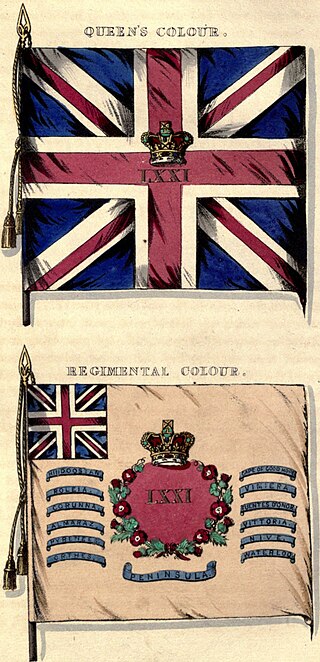
The 71st Regiment of Foot was a Highland regiment in the British Army, raised as the 73rd (Highland) Regiment of Foot in 1777. Under the Childers Reforms it amalgamated with the 74th (Highland) Regiment of Foot to become the 1st Battalion, Highland Light Infantry in 1881.
The 82nd Regiment of Foot (Prince of Wales's Volunteers) was an infantry regiment of the British Army, raised in 1793. Under the Childers Reforms it amalgamated with the 40th (the 2nd Somersetshire) Regiment of Foot to form the Prince of Wales's Volunteers (South Lancashire Regiment) in 1881.
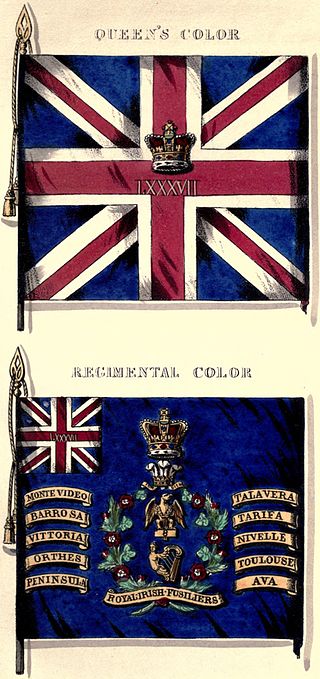
The 87th Regiment of Foot was an infantry regiment of the British Army, raised in 1793. Under the Childers Reforms it amalgamated with the 89th Regiment of Foot to form the Princess Victoria's in 1881.
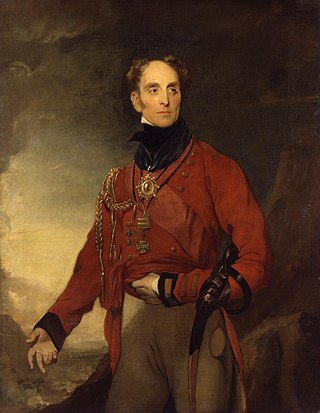
General Sir Galbraith Lowry Cole was an Anglo-Irish British Army officer and politician.
The 85th Regiment of Foot was a British Army line infantry regiment, raised in 1793. Under the Childers Reforms it amalgamated with the 53rd (Shropshire) Regiment of Foot to form the King's Shropshire Light Infantry in 1881.

The 90th Perthshire Light Infantry was a Scottish light infantry regiment of the British Army, raised in 1794. Under the Childers Reforms it amalgamated with the 26th (Cameronian) Regiment of Foot to form the Cameronians in 1881.

General Sir Henry Fane commanded brigades under Arthur Wellesley, 1st Duke of Wellington during several battles during the Peninsular War, and served both as a member of Parliament and Commander-in-Chief of India.

The British Army during the Napoleonic Wars experienced a time of rapid change. At the beginning of the French Revolutionary Wars in 1793, the army was a small, awkwardly administered force of barely 40,000 men. By the end of the period, the numbers had vastly increased. At its peak, in 1813, the regular army contained over 250,000 men. The British infantry was "the only military force not to suffer a major reverse at the hands of Napoleonic France."
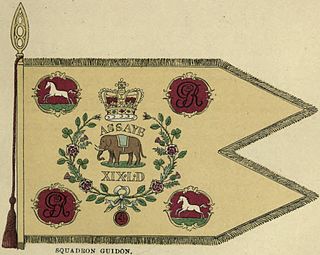
The 19th Light Dragoons was a cavalry regiment of the British Army created in 1781 for service in British India. The regiment served in India until 1806, and in North America during the War of 1812, and was disbanded in Britain in 1821.

Colonel Hugh Henry Mitchell, CB was a British military leader, of Irish birth, who fought in several decisive battles during the Napoleonic Wars, including the Battle of Salamanca and the Battle of Waterloo, and was commended by the Duke of Wellington.
The 9th Light Infantry Regiment was a French army regiment. One of the most notable infantry regiments in the Napoleonic Wars, it was awarded the title "Incomparable" by Napoleon Bonaparte after their brilliant performance at the Battle of Marengo on 14 June 1800. The regiment went on to serve with distinction in the Ulm Campaign, at the Battle of Dürenstein, the Jena Campaign (1806), and the Battle of Friedland. The regiment then served in the Peninsular War taking a notable role at the Battle of Talavera 27–28 July 1809 and the Siege of Badajoz (1812). Battalions from the regiment also fought on the Wagram Campaign (1809), at the Battle of Leipzig, and Napoleon's campaigns in France (1814). During the Hundred Days the 9th Light fought at Battle of Ligny and the Battle of Wavre. The regiment was disbanded in the aftermath of the Bourbon Restoration.
The Militia and Volunteers of County Durham are those military units raised in the County independent of the regular Army. The "modern" militia dates from legislation enacted during the Seven Years' War. The volunteers had several forms and separate periods of existence until made a permanent body in 1859.
Royal Veteran Battalions were British Army units of the early nineteenth century that were made up of men no longer fit for front-line service. They had been previously termed "invalid battalions" but this was deemed derogatory and changed.
The French Imperial Army was the land force branch of the French imperial military during the Napoleonic era.











